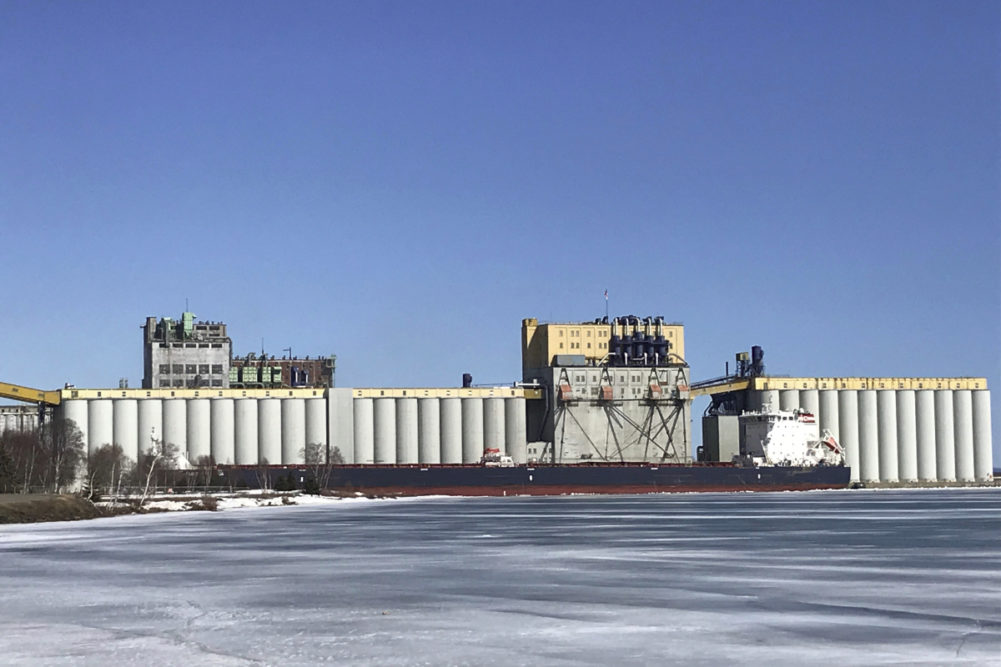THUNDER BAY, ONTARIO, CANADA — As worldwide demand rises for wheat and durum, dozens of ships are expected at the Port of Thunder Bay to export Canadian grain.
According to the Chamber of Marine Commerce, Canadian vessels have loaded 200,000 tonnes of grain in the last week, twice the average volume in March.
On April 1, the Montreal to Lake Ontario section of the St. Lawrence Seaway opened. The opening of that section allows vessels to travel the entire Great Lakes-St. Lawrence River waterway to deliver grain from the Port of Thunder Bay to Quebec, where it will be transloaded onto ocean-going vessels for overseas markets, the Chamber of Marine Commerce said. International vessels are expected to arrive at Thunder Bay in mid-April to receive grain.
“Right now, we expect April grain volumes to be above normal,” said Tim Heney, chief executive officer of the Thunder Bay Port Authority. “We currently have 650,000 tonnes of grain in storage ready to go out and we are receiving more rail deliveries. The port can store more than a million tonnes of grain at a time and has the fastest rail turn-around times, so we are well-positioned to help Canadian farmers supply their markets.”
Canadian grain companies are seeing a jump in demand for bread and pasta.
“We are seeing strong demand for food staples like Canadian wheat and durum with production up at flour mills and pasta plants around the world,” said Carsten Bredin, vice president of grain merchandising at Richardson International Ltd. “Demand was already up in countries like Italy, which had a smaller crop last year but with the COVID-19 pandemic, some countries are ordering extra wheat and durum to increase their reserves and satisfy this new demand. Great Lakes-St. Lawrence shipping is going to be a critical part of the supply chain to move grain to markets in Europe, Northern Africa and the Middle East.”
Despite the new challenges that COVID-19 presents, Canadian grain business are committed to keep supply chains operating efficiently.
“The grain sector has been hit particularly hard this year,” said Wade Sobkowich, executive director of the Western Grain Elevator Association, an association of major grain businesses operating in Canada that collectively handle in excess of 95% of western Canada’s bulk grain exports. “It started with a late harvest and variable quality, and moved to railway labor action, mudslides, and finally blockades.
“Now we are in the midst of trying to move grains, oilseeds and pulse crops to our customers in the midst of a global pandemic. The silver lining is that strong demand exists with our trading partners over the Atlantic in Europe and Africa, and the recognition by governments that it is essential for the grain supply chain to continue to function. The re-opening of Thunder Bay and the St. Lawrence Seaway is critical in order to supply food to the world, and to keep as many people employed as possible during this difficult time.”
Even with the increased shipping traffic the Canadian marine sector implemented protective measures to keep workers and the public safe to help slow the spread of COVID-19. Some of the new safety measures include screening and reporting requirements for ship crews, extra cleaning procedures, hand washing, sanitizing frequently touched surfaces, limiting shore side interactions, keeping physical distancing in the workplace and using protective gear.
“The entire marine supply chain has worked together with government and public health agencies to develop measures that protect the health and safety of our employees and stakeholders,” said Bruce Burrows, president and CEO of the Chamber of Marine Commerce. “We are proud of our ship crews and port-side stakeholders who have quickly mobilized to adapt their operations and go the extra mile to support the Canadian economy and ensure essential products continue to be delivered in this time of crisis.”
Follow our breaking news coverage of the coronavirus/COVID-19 situation.






